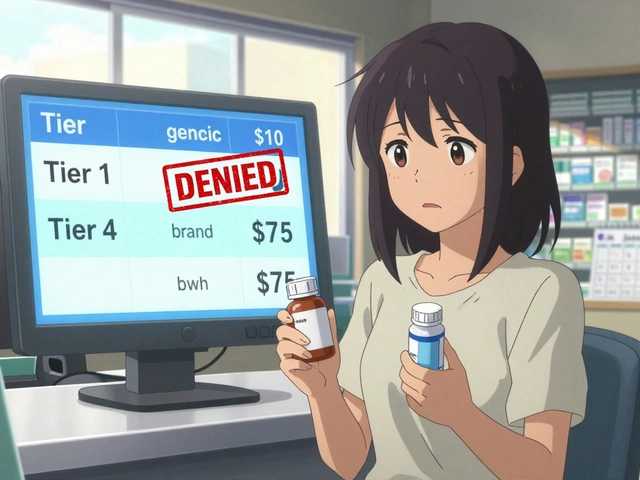Beta Blocker Selector Tool
Which Beta Blocker is Right for You?
Answer a few questions about your health conditions and preferences to get personalized recommendations.
Recommended Beta Blockers
Based on your selections, these medications may be suitable:
Quick Takeaways
- Lopressor (metoprolol) is a cardio‑selective beta blocker most often used for hypertension, angina and post‑heart‑attack care.
- Key rivals-Atenolol, Propranolol, Carvedilol, Nebivolol, and Labetalol-share the same class but differ in selectivity, dosing, and side‑effect profiles.
- If you need strong heart‑rate control and fewer lung‑related side effects, cardio‑selective agents like Lopressor or Atenolol are usually preferred.
- For patients with both hypertension and heart failure, carvedilol or nebivolol often provide added mortality benefits.
- Always match the medication to your specific condition, comorbidities, and tolerance; a one‑size‑fits‑all approach rarely works.
When doctors prescribe Lopressor (generic name: Metoprolol) is a beta‑adrenergic blocker used to lower blood pressure, treat angina and improve survival after heart attacks. It belongs to the broader class of beta blockers-medications that slow the heart’s response to adrenaline, reducing workload on the cardiovascular system. While Lopressor is a household name in the UK and US, many patients wonder how it stacks up against other options on the market. This guide walks you through the science, the side‑effects, and the practical considerations that decide which drug fits your lifestyle.
What is Lopressor (Metoprolol)?
Metoprolol was first approved in the early 1970s and quickly became a staple for cardiologists because of its cardio‑selectivity. Unlike non‑selective beta blockers, it primarily blocks β1 receptors found in the heart, sparing β2 receptors in the lungs. This makes it a safer choice for people with mild asthma or chronic obstructive pulmonary disease (COPD).
Typical brand names in the UK include Lopressor and Seloken; the generic form, metoprolol tartrate, is usually taken 50‑200 mg once or twice daily. There’s also an extended‑release version (metoprolol succinate) marketed as Toprol‑XL, which smooths out plasma levels over 24 hours.
How Metoprolol Works
Beta blockers interfere with the sympathetic nervous system. By blocking β1 receptors, metoprolol reduces heart‑rate (chronotropy) and contractility (inotropy). The net effect is lower cardiac output, less oxygen demand, and a drop in systolic blood pressure. In patients who have suffered a myocardial infarction, this translates into a measurable reduction in mortality and recurrent heart‑attack risk.
Because it’s cardio‑selective, metoprolol doesn’t cause the same degree of bronchoconstriction as non‑selective agents, though high doses can still affect β2 receptors. This nuance matters when you’re weighing one medication against another.
Key Benefits and Common Side Effects
Benefits
- Effective blood‑pressure control (average reduction 10‑15 mmHg systolic).
- Improves angina symptoms by decreasing myocardial oxygen demand.
- Reduces risk of death and re‑hospitalisation after a heart attack.
- Once‑daily dosing possible with the extended‑release formulation.
Typical side effects
- Fatigue or mild dizziness, especially when standing up quickly.
- Cold hands and feet due to reduced peripheral circulation.
- Occasional depression or sleep disturbances.
- Rarely, bradycardia (heart‑rate < 50 bpm) or exacerbation of asthma at high doses.
Most side effects are dose‑related and can be mitigated by titrating slowly.
Popular Alternatives - Quick Profile
Below is a snapshot of the most frequently prescribed alternatives. All belong to the beta‑blocker class but differ in receptor selectivity, additional vasodilatory properties, and typical clinical uses.
- Atenolol - another cardio‑selective blocker, often cheaper but requires twice‑daily dosing for hypertension.
- Propranolol - a non‑selective beta blocker useful for migraine prophylaxis and essential tremor; more likely to cause bronchospasm.
- Carvedilol - a mixed beta‑ and alpha‑blocker offering vasodilation; preferred in chronic heart‑failure patients.
- Nebivolol - cardio‑selective with nitric‑oxide-mediated vasodilation, showing better metabolic profiles in diabetic patients.
- Labetalol - combines beta‑blockade with alpha‑blockade, commonly used in hypertensive emergencies and pregnancy.
Side‑Effect Landscape Across Alternatives
While all beta blockers reduce heart‑rate, their side‑effect spectrum varies. Non‑selective agents like propranolol carry a higher risk of bronchoconstriction and sleep disturbances (nightmares). Mixed alpha‑beta blockers such as carvedilol can cause orthostatic hypotension because of added vasodilation. Nebivolol differentiates itself with a lower incidence of metabolic side effects, making it attractive for patients with type 2 diabetes.
Comparison Table: Lopressor vs Five Alternatives
| Brand | Generic | Typical Daily Dose | Primary Indications | Notable Side‑Effects |
|---|---|---|---|---|
| Lopressor | Metoprolol | 50‑200 mg (once/twice daily) | Hypertension, Angina, Post‑MI | Fatigue, Cold extremities, Bradycardia |
| Tenormin | Atenolol | 25‑100 mg (once daily) | Hypertension, Angina | Dizziness, Sleep issues, Rare bronchospasm |
| Inderal | Propranolol | 40‑320 mg (divided doses) | Migraine, Tremor, Hypertension | Bronchoconstriction, Depression, Fatigue |
| Coreg | Carvedilol | 6.25‑25 mg (twice daily) | Heart failure, Post‑MI, Hypertension | Orthostatic hypotension, Weight gain |
| Nebivol | Nebivolol | 5‑10 mg (once daily) | Hypertension, Heart failure | Headache, Nasal congestion, Rare bradycardia |
| Trandate | Labetalol | 100‑400 mg (divided doses) | Hypertensive emergencies, Pregnancy‑related HTN | Flushing, Liver enzyme rise, Hypotension |

Decision Checklist: Which Beta Blocker Suits You?
Use the following quick‑scan to narrow down the best option based on your health profile.
- Primary condition:
- Isolated hypertension → Metoprolol or Atenolol.
- Heart failure with reduced ejection fraction → Carvedilol or Nebivolol.
- Migraine prophylaxis → Propranolol.
- Pregnancy‑related high BP → Labetalol.
- Respiratory health: Prefer cardio‑selective (Metoprolol, Atenolol, Nebivolol) if you have asthma or COPD.
- Metabolic concerns: Nebivolol shows less impact on glucose tolerance; choose it for diabetics.
- Convenience: Once‑daily dosing is possible with extended‑release Metoprolol, Carvedilol (twice daily), or Nebivolol.
- Cost considerations: Generic atenolol and propranolol are often cheaper; check NHS formularies.
Discuss any checklist results with your prescriber; they can tailor the dose and monitor labs to avoid surprises.
How to Switch Safely
Switching between beta blockers isn’t a DIY project. Here’s a safe pathway:
- Get a written plan from your GP or cardiologist that outlines the tapering schedule.
- Usually, the current drug is reduced by 25‑50 % every 3‑7 days while the new agent starts at a low dose.
- Monitor blood pressure and heart‑rate twice daily during the transition.
- Report any new symptoms-especially dizziness, shortness of breath, or chest pain-immediately.
- Schedule a follow‑up visit within two weeks to adjust the dose.
Never stop a beta blocker abruptly; withdrawal can trigger rebound hypertension or arrhythmias.
Frequently Asked Questions
Can I take Lopressor if I have asthma?
Because Lopressor is cardio‑selective, it’s generally safer than non‑selective beta blockers. However, high doses can still affect lung function, so doctors start low and monitor respiratory symptoms.
What’s the biggest difference between Metoprolol and Atenolol?
Both are cardio‑selective, but Metoprolol has a slightly shorter half‑life, leading many clinicians to prefer an extended‑release formulation for once‑daily dosing. Atenolol is cheaper and often used in generic forms, but it may require twice‑daily dosing for stable blood‑pressure control.
Is Propranolol ever a better choice than Metoprolol?
Propranolol shines for conditions outside the heart, like migraine prevention, essential tremor, and anxiety. Its non‑selective nature makes it less ideal for patients with breathing issues, but for those without respiratory concerns it can be highly effective.
Why might a doctor choose Carvedilol over Metoprolol for heart failure?
Carvedilol blocks both beta and alpha receptors, providing extra vasodilation, which improves cardiac output in heart‑failure patients. Large clinical trials (e.g., COPERNICUS) showed a mortality reduction that’s stronger than with cardio‑selective agents alone.
Can I take Metoprolol with common over‑the‑counter supplements?
Certain supplements-especially those containing high doses of caffeine, ephedra, or ginseng-can counteract the heart‑slowing effect of beta blockers. Always ask your pharmacist before adding new supplements.
Bottom Line
Choosing the right beta blocker is a balance between the condition you’re treating, your other health issues, and how the drug fits into your daily routine. Lopressor offers reliable blood‑pressure control and post‑MI protection with a relatively mild side‑effect profile, making it a go‑to for many clinicians. Yet alternatives like carvedilol or nebivolol may deliver extra benefits for heart‑failure or diabetic patients, while atenolol remains a budget‑friendly option. The best move is to discuss the comparison table and checklist with your healthcare provider and tailor the plan to your unique health picture.







Comments
krishna chegireddy
They tell us Lopressor is just a harmless beta‑blocker, but the pharma lobby hides the truth. Every pill is a pawn in a grand scheme to keep us dependent on synthetic chemicals. The cheap alternatives are deliberately under‑dosed so patients keep coming back for more. If you read between the lines, you’ll see the same pattern: a quiet push toward brand‑name dominance. Wake up before they write the next chapter.
Tamara Schäfer
i've been thinkin about the whole beta blocker saga, and it's like a riddle wrapped in a pill. sure, metoprolol does its job, but what about the unseen side efefcts? sometimes i wonder if the real benefit is just a placebo of confidence. the table is clear, yet my mind keeps circling back to the hidden costs. maybe the best path is to question every line, even when it feels overwhelming.
Benjamin Sequeira benavente
Listen up! If you’re scared about switching, you’re missing the point-change is the engine of progress. Grab the taper plan, follow the schedule, and hit those vitals twice a day like a champ. Push through the fatigue, because every ounce of effort puts you ahead of the disease. Respect your doctor’s orders, but own the process. This is how you turn fear into power.
Shannon Stoneburgh
Anyone still taking generic atenolol clearly doesn’t understand modern cardiology.
ram kumar
Well, here we are again, another endless scroll through drug comparisons. The article drags on, listing every nuance like it’s a masterpiece-yet most of it feels like filler. I could skim the tables and still miss the point, because who has time for such exhaustive detail? The pretentious tone assumes we’re all pharmacology scholars, which is absurd. If you ask me, a simple “pick what works” would suffice.
Melanie Vargas
Hey, don’t be hard on yourself! 🎉 Every bit of info helps you make a smarter choice, even if it feels overload. 😊 If you’re feeling stuck, think of it as a toolbox-pick the tool that fits your situation. 🌟 Remember, no one expects you to memorize every side‑effect; just discuss the big ones with your doc. 🙌
Deborah Galloway
It can be overwhelming to wade through all those beta‑blocker options, but you’re not alone in that feeling. Take a deep breath and focus on what matters most for your health goals. Talk openly with your doctor about your lifestyle, any breathing issues, and cost concerns. Together you can find the right balance that keeps you feeling steady and confident.
Buddy Bryan
When you look at the beta‑blocker landscape, the first thing to notice is the diversity of receptor selectivity. Metoprolol, being cardio‑selective, primarily hits β1 receptors, which spares the lungs and makes it a go‑to for patients with mild COPD. Atenolol shares this selectivity but has a longer half‑life, often allowing once‑daily dosing, though its penetration into the central nervous system is higher, potentially causing more sleep disturbances. Propranolol, on the other hand, is non‑selective; it blocks both β1 and β2 receptors, which can be a disadvantage for asthmatics but useful for migraine prophylaxis. Carvedilol adds an α‑blocking component, giving it vasodilatory effects that are beneficial in heart‑failure patients but also raise the risk of orthostatic hypotension. Nebivolol is unique because it stimulates nitric‑oxide release, offering vasodilation without the α‑blockade, and it tends to have a more favorable metabolic profile for diabetics. Labetalol’s dual β/α blockade makes it a favorite in hypertensive emergencies and pregnancy‑induced hypertension, yet it can cause flushing and liver enzyme elevations. Dosage timing matters: extended‑release metoprolol succinate smooths plasma levels, reducing peaks that could trigger bradycardia. Frequent monitoring of heart rate and blood pressure during any switch is non‑negotiable, as abrupt changes can spark rebound hypertension. The tapering protocol typically involves reducing the current drug by 25‑50 % every few days while introducing the new agent at a low dose. Patients should keep a log of their symptoms, noting any dizziness, shortness of breath, or chest discomfort. Side‑effect profiles also guide selection; for instance, if a patient complains of cold extremities, a drug with less peripheral vasoconstriction like nebivolol may be preferable. Cost considerations cannot be ignored-generic atenolol and propranolol are often the cheapest options, while branded carvedilol may be pricier but justified by clinical benefit in heart failure. Ultimately, the decision rests on a nuanced conversation that weighs indication, comorbidities, lifestyle, and financial factors. By aligning the pharmacologic properties with the patient’s unique picture, you maximize therapeutic success while minimizing unwanted effects.
Jonah O
i read the fine print and saw the same old story-big pharma pushes metoprolol because it keeps the cash flow steady. they hide the real data about long term heart damage in shadow journals. the “clinical trials” are just a front for the elite to control our blood pressure and our minds. dont trust the glossy pamphlets; the truth is buried under layers of regulatory jargon. wake up, question the narrative, and demand real transparency.